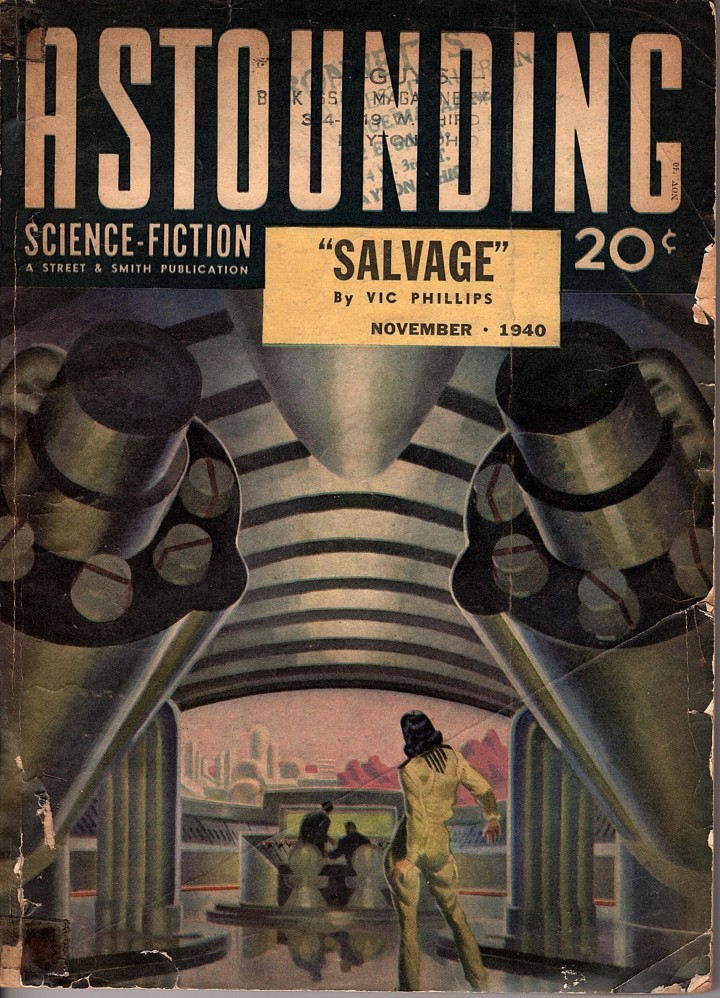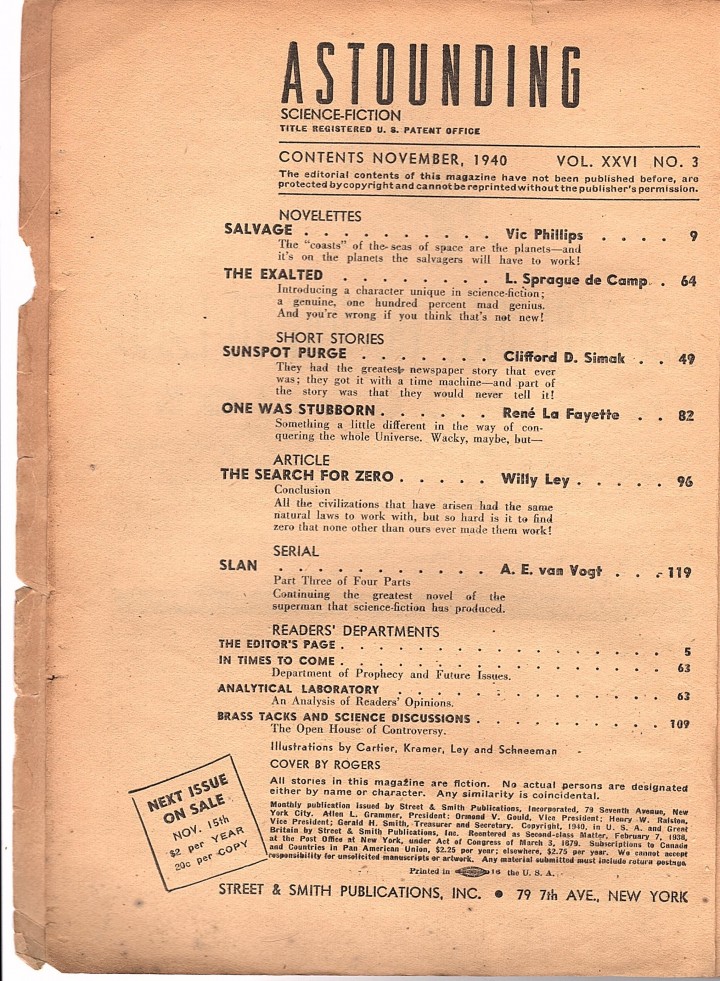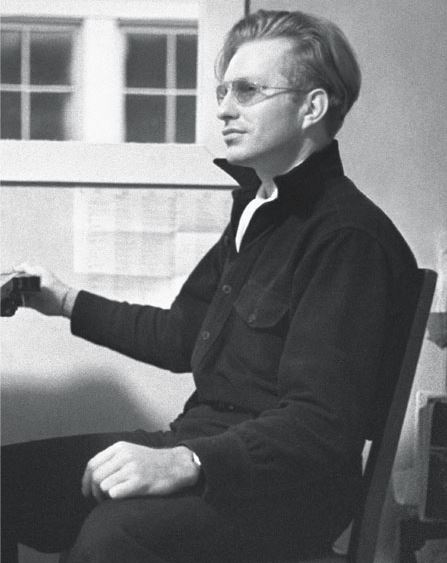We have finally done something that former Church of Scientology member Chuck Beatty has been asking us, or really anyone, to do for the longest time. Yes, Chuck, we have finally read L. Ron Hubbard’s 1940 short story, “One Was Stubborn.”
Beatty is a former Sea Org member who spent one of the longest stints ever in the Sea Org’s prison program, the Rehabilitation Project Force. Scientology claims that the RPF is a voluntary program, sort of like a contemplative resort for its workers who need some time for themselves. Every former Sea Org worker we’ve talked to who went through the RPF described it as a brutal form of imprisonment, sort of like solitary confinement in plain sight. RPFers wear black boiler suits and run from place to place, performing jobs of manual labor while not being allowed to speak to anyone. They eat table scraps, and they have even less contact with the outside world than regular Sea Org workers. Originally, when Scientology founder L. Ron Hubbard designed the RPF, it could take months for an inmate to work him or herself out of it. But later it took much longer to get through the RPF. Beatty spent seven years being punished, from 1996 to 2003, and much of that time at a special desert camp in Southern California called “Happy Valley.” Chuck once described to us how odd it felt to be confined to Happy Valley and completely cut off from the world on the night of December 31, 1999, knowing that the outside world was celebrating.
On our book tour last year, we met someone who said he’d been on the RPF even longer — 11 or 12 years, he told us. We’d like to talk to that fellow again. Anyway, Chuck managed to survive the RPF and the Sea Org, and then he became one of the most active critics of Scientology. He comments a lot here at the Bunker, and time and again he has reminded us about a particular short story that L. Ron Hubbard wrote in 1940, a full decade before he foisted Dianetics on the world.
OK, so we finally decided to do something about it, if for no other reason than to throw Chuck a bone. Anyone who survived seven years in the RPF deserves some consideration.
Well, we looked around to see if “One Was Stubborn” was already online, but we didn’t see it there. We kept running into descriptions of a live performance of the story that had been put out as a DVD by the Galaxy Press troupe of actors who dramatize Hubbard’s stories for retirees and schoolkids. We weren’t interested in that. We wanted the unadulterated source material, not an interpretation from a poorly disguised Scientology front group.
So we continued to search around and then found that a copy of the November 1940 issue of Astounding Science-Fiction was available for a decent price on eBay. Before long, it was in our mailbox…
By November 1940, Astounding was more than two years into its run under the stewardship of legendary editor John W. Campbell. The publication had started out in 1930 with the name Astounding Stories of Super-Science, but Campbell changed the name after he took over full control in 1938. Isaac Asimov credits Campbell with guiding his career and those of many others, and said that Campbell dominated the entire field of science fiction in the first ten years of his editorship. (Campbell died in 1971, while the publication he ran still exists today, as Analog Science Fiction and Fact).
Campbell’s own writing had been in the genre of space opera. As an editor, he pushed writers to dive into “far-out ideas,” Asimov said, including pseudoscientific speculation about the human mind.
In 1940, Lafayette Ronald Hubbard was 29 and already an established pulp writer who toiled in many different genres and under many different names. In 1972, Hubbard’s son, L. Ron Hubbard Jr., wrote this about his father in an unpublished manuscript with journalist Paulette Cooper, portions of which we made public for the first time last year in our book, The Unbreakable Miss Lovely: “He wrote pulp adventure for men’s magazines on the level of the Arabian-Prince-who-saves-the-kingdom and later Dad often wrote that Scientology would save the world. He also wrote westerns, science fiction (he was best-known for this), screen plays, and confession magazine stories as if he were a woman. He was capable of writing in so many styles that he told me on two occasions he wrote every story in one magazine as if he were a different author. He wrote no outlines in advance, made no preparations, and he could write a novelette in one night with no rewrites. It helped that he typed 97 words a minute which was amazing since he only used 4 fingers.”
For the November 1940 Astounding, Hubbard had written a story under the pen name “René La Fayette” in an issue that also featured such familiar names as A.E. van Vogt, L. Sprague de Camp, and Clifford Simak.
“One Was Stubborn” is written as if a manuscript has been found by the author, La Fayette, who identifies himself as a psychiatrist. In his “author’s note,” La Fayette explains that the ensuing story is an account he found in a manuscript written by one of his patients, a man so intractable he has earned the nickname “Old Shellback.”
La Fayette explains that Old Shellback claims to be from the future, and he’s in a panicked state because, he says, he hasn’t come far enough back into the past.
“Tomorrow, my birthday, I shall be a negative five hundred and eighty-nine. I have less than thirty years of life expectancy remaining to me and so I shall not live to be more than a negative five hundred and sixty years.”
This certainly did interest us, and we couldn’t help flashing back to Vincent D’Onofrio trying to convince Marisa Tomei that he was actually from the future in the excellent small 2000 film, Happy Accidents.
Old Shellback hints that his problems are being caused by a man named George Smiley (and we’ll assume it’s just an accident that John le Carré will later use the same name for the protagonist of his well known espionage novels). This Smiley is responsible for upending the entire universe because he is, Old Shellback says, the “one god.”
By the end of the author’s note contained on the story’s first page, we were well intrigued and were looking forward to learning the fate of Old Shellback. We will admit, we’re suckers for this kind of literary device, with a narrator telling us that there’s been a discovery of a manuscript or newspaper article that casts doubt about the very nature of reality. Earlier in 1940, the Argentinean writer Jorge Luis Borges had published a masterpiece of the genre, the short story “Tlön, Uqbar, Orbis Tertius,” in which the discovery of an odd encyclopedia article begins an investigation that uncovers a massive conspiracy to recreate the world.
“One Was Stubborn” is not in that class. Hubbard’s piece is more of a shaggy dog story, with the stubborn Old Shellback discovering — in the far space-faring future, before he has come back in time — that the strange things he’s been seeing are not a symptom of eye trouble, but that solid objects in the world around him really are disappearing. That’s happening because a cult leader, a “messiah” — the aforementioned George Smiley — has convinced everyone in the universe that if they just stopped believing in physical reality, it will all vanish. And so they do.
Only Old Shellback, because he’s so stubborn, is left behind as everyone else follows Smiley into nonexistence.
“The Messiah from Arcturus’ Arcton is teaching the nonexistence of matter. You see, by that he means that all matter is an idea. And it is high time that the world was relieved from the crushing load of materialism which has almost quenched the soul of man,” Old Shellback’s optometrist tells him before he too presumably decides to vanish and become part of “a compound idea.”
Old Shellback is shocked that his doctor seeks nonexistence.
“I know that all this material world and this body I drag around are useless sources of annoyance,” the optometrist responds.
Our readers, who tend to be very familiar with the underlying and esoteric concepts of Scientology, are probably raising their eyebrows to new heights at about this point.
Yes, if you know Scientology, you’ll find a lot of interesting things about “One Was Stubborn” — not the least of which is the date when it appeared, more than five years before L. Ron Hubbard got up to his Crowleyian sex magick rituals with Jack Parsons in Pasadena, and nearly a full decade before he presented his theory of the human mind in his 1950 bestseller, Dianetics: The Modern Science of Mental Health. In this story you’ll find…
— The physical universe existing at the whim of powerful minds.
— The followers of a messiah figure winking off into nonexistence to “return to our proper position as a compound idea.”
— The last hold-out, the most stubborn man in the universe, trying to fight back against nonexistence by willing earth and sun to appear with the power of his mind.
It really isn’t very far from these science fiction tropes to the basic concepts undergirding Scientology and its origin story for the physical universe. That life is a “static,” with “no mass, no motion, no wavelength, no location in space or in time. It has the ability to postulate and to perceive.” And that the universe came into being when powerful thetans — immortal soul-beings — got bored and willed the cosmos into existence and then were trapped in it.
Old Shellback finds himself trapped in the universe of George Smiley, who turns out to have some things in common with a certain sulfurous underworld mythic character. Sartre told us that hell was other people; Old Shellback learns that hell is a world created by the mind of George Smiley, who says he has ideas for a “lower, hotter half” he got “out of an old book.”
(Yes, we know all about that book. Its ideas were implanted in our minds 75 million years ago as a result of a 76-planet genocide carried out by a galactic overlord. Or, at least that’s what high-level Scientologists learn after paying enough money to reach something called “Operating Thetan Level Three.”)
In 1940, Hubbard has Old Shellback, who has come from 500 years in the future, make numerous references to a book, “Tribbon’s Rise and Fall of the American Empire,” which explains our country’s demise, apparently at the hands of — get this — unscrupulous cult leaders who take advantage of “willing dupes for religious experimentation.” But Smiley has outdone them all. Why? Well, in the future, “the perfection of communication … made it possible for George Smiley to reach everyone everywhere. And the freedom which the Machine Magistration gave all religious exponents accounted for George Smiley’s not being stopped.”
In other words, Smiley used advancements in communication technology to become a Messiah with tax exempt status, and then there was no stopping him.
It’s almost as if, ten years before anyone else saw it coming, L. Ron Hubbard has a pretty good idea for how to sway a lot of people and get them to drop out of their existences in the physical world — by telling them they’ll be able to regain the power they had trillions of years ago when they were the creators of universes. And along the way, you make sure you get protection from the “Machine Magistration” for your religious cloaking.
Seriously, this is spooky.
In the movie Going Clear, author Lawrence Wright says that Hubbard had obviously incorporated the ideas from his fiction in Scientology. And in 2014, we brought you news of scholar Susan Raine’s excellent investigation of the parallels between Hubbard’s space opera tales and concepts in Scientology.
But Raine doesn’t mention “One Was Stubborn” in that piece. And maybe because it’s not a tale of space opera predicting outlandish ideas like Marcabian invader forces or between-lives implanting stations on Mars or Venus. This is more eerily on the money: “One Was Stubborn” literally predicts a cultish Messiah figure taking over the universe by convincing people they can make physical reality vanish with the power of their minds.
This is “cause over life, thought, matter, energy, space and time” — and 27 years before Hubbard dreams up OT VIII. We get chills thinking about it.
As a story, however, this stuff pretty much blows. What anticipation we’d built up after the author’s note on the first page had pretty well dissipated by the end of this 14-page slog. Old Shellback is a cranky old bore, and smug George Smiley can go to the hell he has decided to create out of his cerebral cortex.
But if “One Was Stubborn” is not very good as science fiction, as a piece of the Scientology puzzle it has us feeling a little like Howard Carter here. And we have Chuck Beatty to thank for it.
We’d really like to get your thoughts on this story. What surprises you most about it, given what Hubbard would develop for Scientology later on?
Ten years after this short story appeared, in the May 1950 issue of Astounding, Hubbard’s “Dianetics” would make its first public appearance in the pages of John W. Campbell’s magazine, followed a few weeks later by the book version itself.
We expect that none of the magazine’s readers at the time made any connection between Hubbard’s “modern science” of the mind and a shaggy dog story printed a decade earlier under the name René La Fayette. But with hindsight, it looks like that’s a connection we need to pay closer attention to.
UPDATE: A knowledgeable reader of Astounding pointed out to us that each month, Campbell asked readers to vote on which story they found best in the magazine. A couple of issues later, he would print the results. In this case, it turned out that “One Was Stubborn” was not very popular with readers, and came in fourth out of five stories that issue…
ANALYTICAL LABORATORY
…
1. Slan (A. E. van Vogt), 1.24 points
2. Salvage (Vic Phillips), 2.45
3. The Exalted (L. Sprague de Camp), 2.78
4. One Was Stubborn (Rene La Fayette), 3.33
5. Sunspot Purge (Clifford D. Simak), 4.5
——————–
 Posted by Tony Ortega on February 15, 2016 at 07:00
Posted by Tony Ortega on February 15, 2016 at 07:00
E-mail tips and story ideas to tonyo94 AT gmail DOT com or follow us on Twitter. We post behind-the-scenes updates at our Facebook author page. After every new story we send out an alert to our e-mail list and our FB page.
Our book, The Unbreakable Miss Lovely: How the Church of Scientology tried to destroy Paulette Cooper, is on sale at Amazon in paperback and Kindle editions. We’ve posted photographs of Paulette and scenes from her life at a separate location. Reader Sookie put together a complete index. More information about the book, and our 2015 book tour, can also be found at the book’s dedicated page.
Learn about Scientology with our numerous series with experts…
BLOGGING DIANETICS: We read Scientology’s founding text cover to cover with the help of L.A. attorney and former church member Vance Woodward
UP THE BRIDGE: Claire Headley and Bruce Hines train us as Scientologists
GETTING OUR ETHICS IN: Jefferson Hawkins explains Scientology’s system of justice
SCIENTOLOGY MYTHBUSTING: Historian Jon Atack discusses key Scientology concepts
Other links: Shelly Miscavige, ten years gone | The Lisa McPherson story told in real time | The Cathriona White stories | The Leah Remini ‘Knowledge Reports’ | Hear audio of a Scientology excommunication | Scientology’s little day care of horrors | Whatever happened to Steve Fishman? | Felony charges for Scientology’s drug rehab scam | Why Scientology digs bomb-proof vaults in the desert | PZ Myers reads L. Ron Hubbard’s “A History of Man” | Scientology’s Master Spies | Scientology’s Private Dancer | The mystery of the richest Scientologist and his wayward sons | Scientology’s shocking mistreatment of the mentally ill | Scientology boasts about assistance from Google | The Underground Bunker’s Official Theme Song | The Underground Bunker FAQ
Our Guide to Alex Gibney’s film ‘Going Clear,’ and our pages about its principal figures…
Jason Beghe | Tom DeVocht | Sara Goldberg | Paul Haggis | Mark “Marty” Rathbun | Mike Rinder | Spanky Taylor | Hana Whitfield










